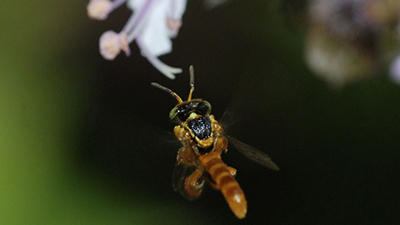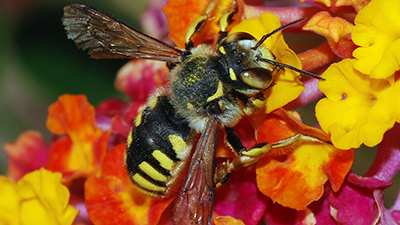Global Pollinator Watch
Join Us to Reduce Global Pollinator Decline
Recent studies have found insect populations to be declining globally at rapid and alarming rates, likely impacting the many vital ecological services they provide. Pollinator decline, in particular, is a massive concern because of its impacts on food production, human health, and ecosystem functioning, including the capacity of plants to provide essential services such as carbon sequestration.
The goal of Global Pollinator Watch, a home-based citizen science program, is to equip members of the public with the training and resources they need to collect data that will help us to better understand pollinator presence and abundance in regions around the world. These data will enable us to track the critical timing of pollinator activity and the host plants that they rely on for part of their life cycles, and ultimately, to help reduce pollinator decline.
Pollinator observation data will help answer these research questions:
- How does human development impact pollinator diversity and abundance? Are certain activities more likely to affect insect and pollinator decline?
- Are areas that are experiencing declines of key pollinator species also experiencing declines in other species (e.g., grassland birds or amphibians)?
- Is climate change causing the life cycles of flowers and pollinators to get out of sync?
.
.
Research Background
 There are a number of drivers of pollinator decline, including habitat loss, increases in invasive plant species, use of pesticides and herbicides, regional declines in air and water quality, and a changing climate. But our knowledge about the decline in pollinators is limited to a few studies, in a few places, in a few different habitats. It is also limited to only a subset of species. We are prioritizing observations of four orders of insects: butterflies and moths (Lepidoptera), bees, wasps, ants and sawflies (Hymenoptera), flies (Diptera) and beetles (Coleoptera). Collectively, these four orders represent nearly half of the described species of animals on earth.
There are a number of drivers of pollinator decline, including habitat loss, increases in invasive plant species, use of pesticides and herbicides, regional declines in air and water quality, and a changing climate. But our knowledge about the decline in pollinators is limited to a few studies, in a few places, in a few different habitats. It is also limited to only a subset of species. We are prioritizing observations of four orders of insects: butterflies and moths (Lepidoptera), bees, wasps, ants and sawflies (Hymenoptera), flies (Diptera) and beetles (Coleoptera). Collectively, these four orders represent nearly half of the described species of animals on earth.
To be able to act with greater certainty, managers and scientists need access to more information about which species are being most heavily impacted, which landscapes are most at risk of losing critical pollinators, which threats need to be mitigated, and which solutions might prove to be most effective. To date, much of the existing data have been gathered by citizen scientists working together with researchers. Pollinator monitoring is an area where citizen science can be a really useful approach—as evidenced by the many Earthwatch projects that include insects and pollinators as part of their field research. We are now looking to further catalyze this citizen science effort to generate data useful to pollinator conservation efforts globally—by having people collect observations in their backyards, at their schools and workplaces, in community parks and gardens, and more.
.
.
Data Collection
We are using the online platform iNaturalist to collect observations from citizen scientists (that’s where you come in!), and have created two levels of involvement in the project.
- Level 1: Set up an account on iNaturalist and join the Global Pollinator Watch project. Any observations you submit of species within any of those four target orders of insects will automatically become associated with the project. Easy breezy.
- Level 2: Set up an account on iNaturalist and join the project and—as above—those target observations become associated with Global Pollinator Watch. As we are also interested in the interactions with the host flowers they are found on—including mismatches in the timing of the flowers and their important pollinators—we provide some structure around connecting your insect observation with the species of flower it was photographed on, through some specific “Observational Fields” within iNaturalist, a process described on the Global Pollinator Watch project description page in iNaturalist. To learn how to document species interactions, read our guide.
Both levels are actually pretty easy to contribute to, and both allow your contributions to expand upon the available data and thus our understanding of what is happening with these incredible and vital creatures around the world.
Good photos are critical for species identification, and for training the artificial intelligence (AI) pattern recognition algorithms in iNaturalist. Here are some tips on how to capture high-quality photos of pollinators.
.
Earthwatch Pollinator Expeditions

Conserving Wild Bees and Other Pollinators of Costa Rica
Bees, hummingbirds, and other pollinators provide services that are critical to our future food security and the ecological health of the planet. Help scientists conserve these crucial species.

Cracking the Code: the Mysteries of Native Bees in Utah
Join researchers in the towering mountains and verdant forests of Utah to monitor the health and diversity of bee populations.
Tracking Caterpillars in Tropical Forests
How much can the humble caterpillar tell us about the world we live in? More than you might imagine.
.
YOUR SUPPORT MATTERS
Earthwatch depends on donations—above and beyond what we raise from volunteers who participate on our expeditions—in order to deliver our global conservation mission. In fact, volunteer contributions provide only half of the total resources Earthwatch needs to sustain over 40 field research expeditions, a wide variety of educational programs, corporate sustainability trainings, and more each year.
Sign up for the Earthwatch Newsletter
Be the first to know about new expeditions, stories from the field, and exciting Earthwatch news.
.
.
.